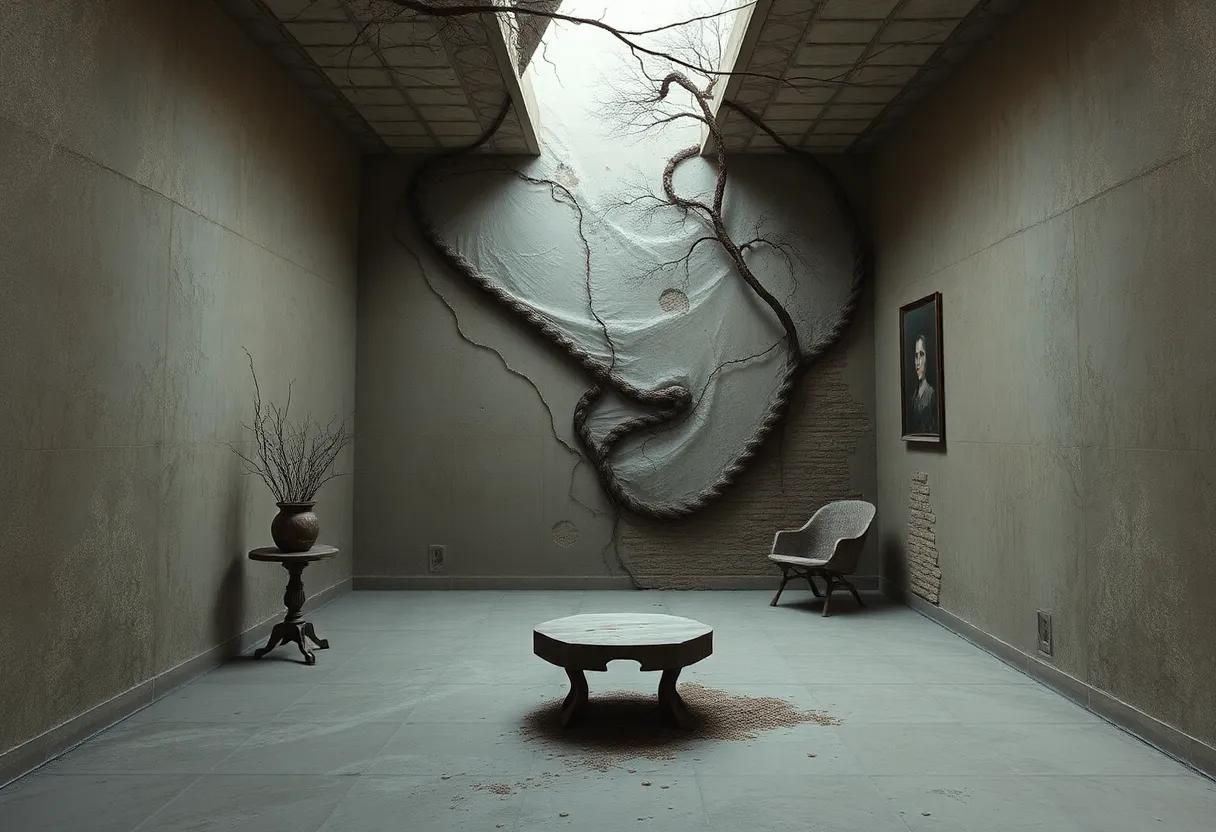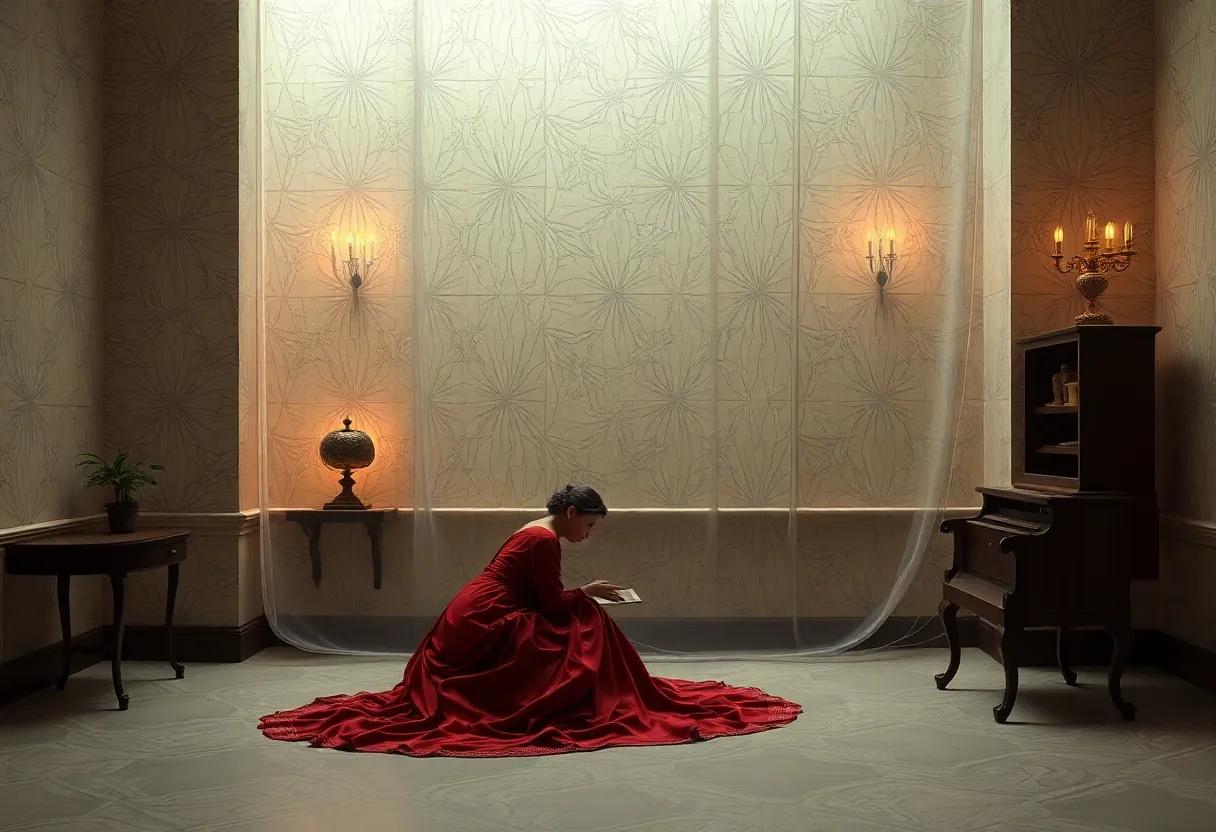In the labyrinthine streets of 19th-century Paris, where the flickering gaslights cast long shadows over both opulence and despair, Émile Zola’s “Nana” reveals a narrative woven with threads of desire and decay. This masterful novel not only charts the tumultuous rise and fall of its titular character, a captivating courtesan, but serves as a striking commentary on the moral landscape of an age marked by ambition and excess. Zola’s incisive prose pierces through the veneer of Parisian society, inviting readers to confront the stark realities of love, power, and the inevitable decline that follows relentless pursuit. As we delve into ”Unveiling Desire and Decay,” we uncover not just a tale of one woman’s journey, but a profound exploration of the human condition, set against the backdrop of a city that both nourishes and devours its inhabitants. Join us as we dissect the intricate layers of Zola’s work, examining its enduring themes and the societal reflections that resonate even today.
Exploring the Complexities of Gender in Émile Zola’s Nana

In ‘Nana,’ Zola dissects the very essence of femininity against a backdrop of the Second Empire, where the intersection of desire and decay becomes evident. Nana, the protagonist, epitomizes the struggles and contradictions faced by women in a patriarchal society. She navigates through a world that both objectifies and commodifies her, using her beauty as a weapon while simultaneously contending with her own disempowerment. Zola skillfully illustrates how societal expectations and personal aspirations intertwine, resulting in a complex portrayal of a woman who embodies both the allure and the plight of her time. This duality is further heightened by her relationships with various men—each of whom serves as a mirror reflecting societal attitudes toward women, showcasing a tangled web of exploitation and empowerment.
The novel also serves as a critique of the superficial values of bourgeois society, emphasizing the fragility of both human connection and moral integrity. As Nana rises to fame and fortune,she becomes a symbol of decadence,revealing the transitory nature of success and desirability. Zola’s exploration of gender dynamics unveils a harsh reality where women are often trapped in a cycle of consumption and consumption of themselves, epitomized by the following elements:
- Objectification: Nana’s beauty becomes her prison.
- Exploitation: Relationships are transactional, devoid of genuine connection.
- Empowerment vs. Entropy: Her rise is as spectacular as her inevitable decline.
By presenting these themes through Nana’s tragic journey, Zola not only critiques the societal structures that shape gender roles but also invites readers to reflect on the broader implications of desire within a decaying moral landscape.
The Rich Tapestry of Parisian Society in the Late 19th Century

In Émile Zola’s Nana, the vivid portrayal of late 19th-century Parisian society unearths a world brimming with contradiction and complexity. Zola meticulously crafts a narrative that encapsulates the extremes of wealth and poverty, revealing two contrasting realities coexisting in the heart of the French capital. Among the grand theaters and opulent ballrooms,the lives of the elite intermingle with the struggles of the lower class,as the protagonist,Nana,oscillates between their worlds,embodying the allure and decay surrounding her. Through her rise—a journey marked by both seduction and despair—readers are invited to explore a society teetering on the brink of transformation.
This tapestry of Parisian life is woven from a multitude of threads, including:
- The Flourishing Arts: The era’s artistic movements, with Impressionism at the forefront, reflect the dynamic cultural landscape.
- The Industrial Revolution: A time of economic change, where the emergence of new industries alters social dynamics.
- Class Dichotomy: The stark divide between the affluent and the impoverished, accentuated by Nana’s very existence.
- Feminine Agency: Nana’s character challenges traditional gender roles, offering insight into women’s empowerment and societal constraints.
| Aspect | Details |
|---|---|
| Social Class | Elitism vs.destitution |
| Gender Roles | Female empowerment vs. oppression |
| Cultural Shifts | Artistic innovation vs. traditional values |
Desire as Power: The Provocative Role of Female Agency in Nana

the character of Nana in Émile Zola’s narrative serves as a captivating embodiment of female agency, transcending traditional representations of women in literature. Through her seduction and manipulation of the men around her, Nana embodies desire not merely as a vehicle for personal gain but as a form of power that reveals the intricacies of societal norms and gender dynamics of the time. Her sexual exploits unveil a paradox where her desirability becomes a tool of liberation, yet simultaneously entraps her in a cycle of decay, exposing the inherent flaws within the patriarchal structures that both empower and consume her.
in this complex interplay, Nana becomes a mirror reflecting the desires and vices of the men who pursue her. Zola illustrates that her allure is not just physical; it encompasses a profound emotional influence that unsettles societal conventions. This duality can be seen in the following aspects:
- Manipulation of Masculine Desire: Nana capitalizes on the vulnerabilities of the men around her, turning their emotional investments into a source of her own strength.
- Commercialization of Femininity: zola highlights how her beauty is commodified, presenting both empowerment and exploitation.
- cycle of Decay: Despite her power, Nana’s storyline suggests that such agency ultimately leads to a tragic downfall, illustrating the cost of her dominance.
This dynamic tension between desire and decay is succinctly encapsulated in the following table, which summarizes the dual aspects of Nana’s agency:
| Aspect | empowerment | Consequences |
|---|---|---|
| Relationships | Controls and seduces men | Manipulated by her own tactics |
| Societal Role | Challenges traditional norms | Ultimately isolated and diminished |
| Personal Identity | Defines her own destiny | Engulfed by her façade |
Decadence and Decline: Analyzing Themes of Morality and Destruction

In Émile Zola’s ‘Nana’, the intertwining themes of morality and destruction resonate through the lives of its characters, creating a vivid tableau of 19th-century Parisian society. the protagonist, Nana, embodies the epitome of decadence, using her beauty and charm to seduce the powerful elite while simultaneously exposing their moral decay. Through her rise from the streets to the heights of society,Zola illustrates the transience of wealth and the inherent corruption that underlies the glamour. Nana’s existence serves as a haunting reminder that the pursuit of pleasure is often intertwined with a disregard for ethical boundaries, leading to ultimate self-destruction not only for her but also for those who succumb to her allure.
The relentless cycle of indulgence culminates in a catastrophic downfall that reflects not just Nana’s demise but also serves as a metaphor for a society in decline. The lavish lifestyles led by the characters are juxtaposed with stark realities—their lives oversaturated with excess reveal a foundational emptiness. Zola deftly crafts a world where the facade of beauty and opulence hides the ruins of decadence beneath. As each character becomes ensnared in their desires, a palpable tension mounts, ultimately revealing that the pursuit of pleasure is not without devastating consequences, as exemplified in the table below:
| Character | Desire | Consequences |
|---|---|---|
| Nana | Power and Wealth | Isolation and Death |
| Pigalle | Obsession | Financial Ruin |
| Count Muffat | Love | Public Shame |
Characterization in Nana: A Deep Dive into Zola’s Intriguing Protagonist

Émile Zola masterfully crafts Nana as a complex tapestry woven with threads of ambition, desire, and disillusionment. As the protagonist of the eponymous novel, Nana embodies the seductive allure of Parisian nightlife, captivating everyone from the bourgeois elite to the struggling working class. Her vulnerability and charisma clash with the brutal realities of her surroundings, leading to a powerful exploration of femininity within a patriarchal society. Zola intricately depicts how her relationships with men—be they lovers or benefactors—are steeped in a commodified understanding of desire, showcasing how intimacy can become a transaction handsomely disguised as affection.
Nana’s character invites readers to reflect on the paradoxes of beauty and decay, presenting her as both a victim and a conqueror.Her rise to fame and fortune is accompanied by a gradual decline,mirroring the decadence of the society that adores her. Zola captures this duality in her encounters, where moments of glamour are quickly overshadowed by an impending sense of demise. Through her eyes, we come to understand the ephemeral nature of success and the inevitable return to oblivion, a theme underscored by the following key attributes:
| Attribute | Description |
|---|---|
| Ambition | A relentless pursuit of social elevation and personal fulfillment. |
| Decadence | Illustrates the fleeting pleasures of luxury and the cost of excess. |
| Isolation | Despite her fame, a profound loneliness that accompanies her choices. |
| Resilience | A strong-willed spirit confronting societal norms and personal demons. |
The Stylistic Brilliance of Zola: Language and Imagery that Captivates

Émile Zola’s narrative prowess in “Nana” transcends the boundaries of mere storytelling, weaving a rich tapestry of language and imagery that immerses readers in the decadence of the Belle Époque. His meticulous attention to detail vividly captures the essence of Parisian life, from the opulence of high society to the underbelly of desperation that lies hidden beneath the surface. Zola employs a sensory approach, allowing readers to feel the intensity of nana’s journey, immersing them in the sights, sounds, and smells of the era: the tantalizing aroma of flowers in a lavish soirée, the depth of the smoky brothels, and the vibrant colors of both extravagant gowns and the more somber realities of street life. The juxtaposition between beauty and decay becomes a recurring motif,inviting readers to grapple with the stark contrasts that define the human experience.
Through his innovative use of imagery, Zola articulates profound themes of desire and decay, allowing the characters to pulsate with life despite their tragic circumstances. Notably, his metaphorical descriptions bring forth an array of emotions, as when Nana is depicted not just as a woman but as a vivid personification of temptation itself. Zola’s lyrical prose enhances the atmosphere, creating moments that resonate powerfully on both a personal and social level. The author strategically employs symbolism, such as the recurring images of mirrors reflecting both flattery and truth, to emphasize the duality of appearances versus reality. This mastery of language not only captivates his audience but also ensures that Nana lingers in the minds of readers long after the final pages are turned.
Social Critique through Personal Narratives: Zola’s Commentary on Class and Wealth

Émile Zola’s ”Nana” serves as a vivid tableau of the intersections between personal desire and societal decay, encapsulating the profound impact of class dynamics on individual lives. Through the lens of Nana, a captivating yet tragic figure, Zola explores how wealth is both a catalyst for ambition and a harbinger of moral degradation. Her rise from the streets of Paris to the heights of the bourgeoisie illustrates the intoxicating lure of affluence, yet simultaneously reveals the emptiness that can accompany such success. The narrative unfolds like a finely woven tapestry, abundant with rich detail that invites readers to examine the consequences of a society that equates worth with monetary gain.
In Zola’s world, personal narratives intertwine seamlessly with social critique, highlighting the discrepancies between the classes. The stark juxtaposition between the opulence of the wealthy and the desolation of the proletariat is unflinchingly portrayed through various character studies. Consider the following aspects of Zola’s commentary:
- Wealth as corruption: Nana’s luxurious lifestyle ultimately leads to her moral bankruptcy.
- Class Disparity: Each character embodies distinct social strata, underscoring the stark divisions in Parisian society.
- Fleeting Desires: The ephemeral nature of pleasure serves as a metaphor for the transient nature of success.
This unraveling of personal ambition casts a critical eye on the structures that bind individuals to their fates,raising questions about the cost of desire and the price of societal ambition. Zola’s masterful storytelling not only captivates but provokes thought, inviting readers to reflect on their own values and the silent complexities of societal structure.
Symbolism of Decay: The use of Metaphors in Zola’s Narrative

In Émile Zola’s Nana, decay serves as a poignant metaphor for the inevitable decline of both individual virtues and societal morals. The protagonist, Nana, embodies this decay, reflecting the broader themes of urban life in 19th-century Paris. Through vivid descriptions of her opulent yet degrading surroundings, Zola uses sensory imagery to illustrate the allure and eventual disintegration of beauty. The juxtaposition of Nana’s physical allure and her subsequent moral deterioration highlights a world where desire leads to destruction, revealing the ephemeral nature of pleasure. This interplay is further emphasized by the sordid environments in which Nana finds herself, symbolizing not just her personal demise but also the erosion of social values.
the language employed by Zola frequently enough evokes visceral reactions, illustrating a world caught in a cycle of indulgence and decay. this is exemplified through various motifs, such as:
- Corruption of Innocence: Many characters surrounding Nana fall victim to her enchantment, illustrating how innocence succumbs to the allure of vice.
- Decay of the Body: Nana’s gradual physical decline parallels her moral degradation, emphasizing the close relationship between corporeal and spiritual decay.
- Urban Decay: The backdrop of a crumbling Paris underscores the inevitability of decline within society itself.
In exploring these themes, Zola not only crafts a tale of personal and societal disintegration but also invites the reader to reflect on the broader implications of desire intertwined with decay.Each character,trapped in the web of Nana’s charm,showcases the seductive yet ultimately destructive power of human desire,reinforcing the notion that beauty may indeed be but a fleeting illusion.
Unraveling the Tragedy of Desire: Emotional Depth in Nana’s Relationships

The relationships in Nana are a poignant reflection of human desire and its inevitable decay. Zola intricately weaves a narrative that showcases Nana’s impact on those around her, highlighting how her beauty and sensuality ignite a consuming passion. Throughout the novel,characters ensnared by their desires reveal a spectrum of emotional struggles—each encounter signaling a deterioration of moral values and a descent into self-destruction. Her lovers, ranging from the affluent to the desperate, are lured into her world only to find themselves grappling with their own weaknesses and insecurities.
many aspects of Nana’s connections shed light on the interplay between power and vulnerability in relationships. Zola presents a cast of characters who are often left disillusioned, marking the cyclical nature of desire: what begins as a passionate affair often leads to betrayal, despair, and decay.The following table summarizes key relationships in Nana’s life, exemplifying their emotional depth and resulting tragedies:
| Character | Relationship Type | Emotional outcome |
|---|---|---|
| Graf Muffat | Affair | Destruction of his marriage |
| Count de Vrigny | Patron | Obsessed and consumed by desire |
| Laure | Rival | Jealousy and betrayal |
| Jules | Friend | Self-destruction through gambling |
A Comparative Perspective: Nana within the Naturalism Movement

Émile Zola’s ‘Nana’ serves as a poignant illustration of the naturalism movement, a literary genre that seeks to represent reality with uncompromising honesty. At the heart of Zola’s narrative lies the portrayal of Nana, a woman whose sensuality captivates the Parisian elite, yet thrusts her into a world rife with exploitation and moral decay. In naturalism, characters are often viewed as products of their environment, and nana’s ascent from an impoverished upbringing to a lavish life as a courtesan is emblematic of the forces shaping her destiny. This intricate interplay of desire and degradation highlights how societal constructs dictate the trajectories of individuals, positioning Nana as both a victim and a catalyst of her circumstances.
Through the lens of naturalism, Zola delves into the darker aspects of human experience, unearthing the interplay between instinctual drives and the societal framework. Nana’s life becomes a canvas upon which themes of temptation, corruption, and the primal struggle for survival are vividly painted. The novel paints her not merely as a character, but as a representation of the broader societal decay, challenging readers to explore the following elements that intertwine throughout the narrative:
- The Impact of Class: Nana’s journey illustrates the ruthless nature of social hierarchy, where the elite are frequently enough depicted as morally bankrupt.
- Gender Dynamics: As a female protagonist, Nana’s navigation through a male-dominated world exemplifies the struggles faced by women in pursuit of autonomy.
- Desire and Decay: Her relationships echo the seductive allure of opulence alongside the inevitable degradation that accompanies it.
Enduring Relevance: How Nana speaks to contemporary Issues of Feminism

Émile Zola’s “Nana” emerges as a powerful lens through which contemporary feminist discourse can be examined. The character of Nana herself is a complex amalgamation of strength, vulnerability, and agency, reflecting the multifaceted nature of womanhood in modern society. her rise from poverty to becoming a celebrated courtesan serves as a bold statement on the societal constructs surrounding female identity and empowerment. In a world that often reduces women to stereotypes, nana embodies a kind of defiance that resonates today, showcasing how the fight for autonomy can lead to both personal liberation and societal critique. as we explore her life choices and the repercussions they bring, we see echoes of today’s ongoing battles against patriarchy and the struggle for women’s rights.
Furthermore,Zola’s portrayal of gender dynamics invites reflection on the intersections of desire,commodification,and societal expectation. Through Nana, we witness the entrapment of women within the margins defined by men and money, raising pertinent questions about the price of freedom and self-determination. This theme is not only relevant but imperative in discussions surrounding the sexualization of women in media today. A closer examination reveals parallels such as:
- The objectification of female bodies in both 19th-century Paris and modern advertising.
- The critique of societal norms that demand women conform to specific roles.
- The quest for authenticity amidst a landscape of societal expectations.
ultimately, “Nana” doesn’t simply narrate a woman’s story; it acts as a mirror reflecting our current societal landscape and the persistent dialogues surrounding feminism. As we delve into the lives of characters shaped by their environments, Zola compels readers to confront not only the ancient context of women’s struggles but also their enduring relevance in the contemporary world.
Recommendations for Readers: Who Will Find Resonance in nana?

Readers who are intrigued by the interplay of beauty, ambition, and the darker sides of human nature will find themselves captivated by Émile Zola’s exploration of desire and decay in ‘Nana’. This novel speaks to those who appreciate stories that delve into the complexities of femininity and societal roles.Key audiences might include:
- Fans of Naturalism: If you enjoy literature that emphasizes realism and the influences of environment and heredity on character, ‘Nana’ will resonate deeply.
- Historical Fiction Aficionados: Readers who cherish narratives steeped in the historical context of 19th-century france will be drawn to its rich depiction of Parisian life.
- Explorers of Feminist Themes: Those looking to understand the struggles and celebrations of female empowerment through the lens of a complex, flawed protagonist will find much to ponder.
additionally, literary enthusiasts who relish character-driven plots will appreciate Zola’s intricate portrayal of personal ambitions set against the backdrop of society’s moral decay.The novel invites:
- Psychological Explorers: Readers keen on understanding the psychological motifs behind desires and the consequences of unchecked ambition.
- Culture Critics: Those interested in the sociocultural commentary that reflects industrialization and its impact on human interactions.
- Art and Aesthetics Buffs: Individuals fascinated by how beauty and art intersect with degradation and exploitation will find zola’s vivid descriptions to be profoundly engaging.
Émile Zola: The master Storyteller Behind the Veil of Desire and Decay

Émile Zola masterfully wields the pen, crafting narratives intertwined with the threads of desire and decay.in ‘Nana’, Zola unveils the stark realities of Parisian life through the lens of his captivating protagonist, a courtesan whose beauty and allure mask the moral rot that permeates society. With a keen eye for detail, Zola paints a vivid picture of the opulence surrounding Nana, contrasting it against the spiritual and physical degradation she experiences. His exploration of the human condition reflects profound insights into the obsessions and follies that drive people to seek pleasure, even at the cost of their dignity.
The novel is a rich tapestry of characters, each contributing to the unfolding drama of decadence. Here, the author’s focus on societal hypocrisy becomes glaringly evident. The narrative follows a distinct structure, revealing layers of complexity within its simplistic allure. Key elements include:
- Desire: Zola emphasizes the insatiable hunger for love and validation.
- Decay: The physical and moral degradation of both Nana and the society around her is poignantly illustrated.
- Power Dynamics: Relationships are often transactional, exposing the underlying greed that fuels desire.
Through these themes, Zola compels readers to confront uncomfortable realities, challenging them to see beyond the glamorous façade. In essence, ‘Nana’ serves not only as a tale of one woman’s rise and fall but as an indictment of a society blinded by lust and ambition, making Zola an enduring figure in the literary exploration of human vice.
Future Outlook
As we close the pages on “Unveiling Desire and Decay,” Émile Zola’s “Nana” stands as a testament to the intricate dance between ambition and despair, beauty and rot. Through the lens of Nana’s tumultuous journey,Zola invites us to examine the undercurrents of society,revealing the fragility of human desire amidst the unrelenting grip of decay. As we reflect on the threads woven into this complex tapestry, we are left contemplating the inescapable truths of our own desires and the often harsh realities that accompany them.
In navigating the streets of 19th-century Paris, we realize that Zola’s insights are not merely relics of a bygone era but resonate with our contemporary struggles. The characters we encounter, vivid and flawed, linger in our minds, prompting us to question the cost of our own pursuits and the masks we wear.
In this exploration, we find that literature does not merely mirror life but holds up a mirror to our own unexamined selves, encouraging introspection and understanding. As we close this chapter,let us carry forth the echoes of Zola’s powerful narrative,always aware that beneath the glitz of desire lies the profound and often uncomfortable truth of human existence.











